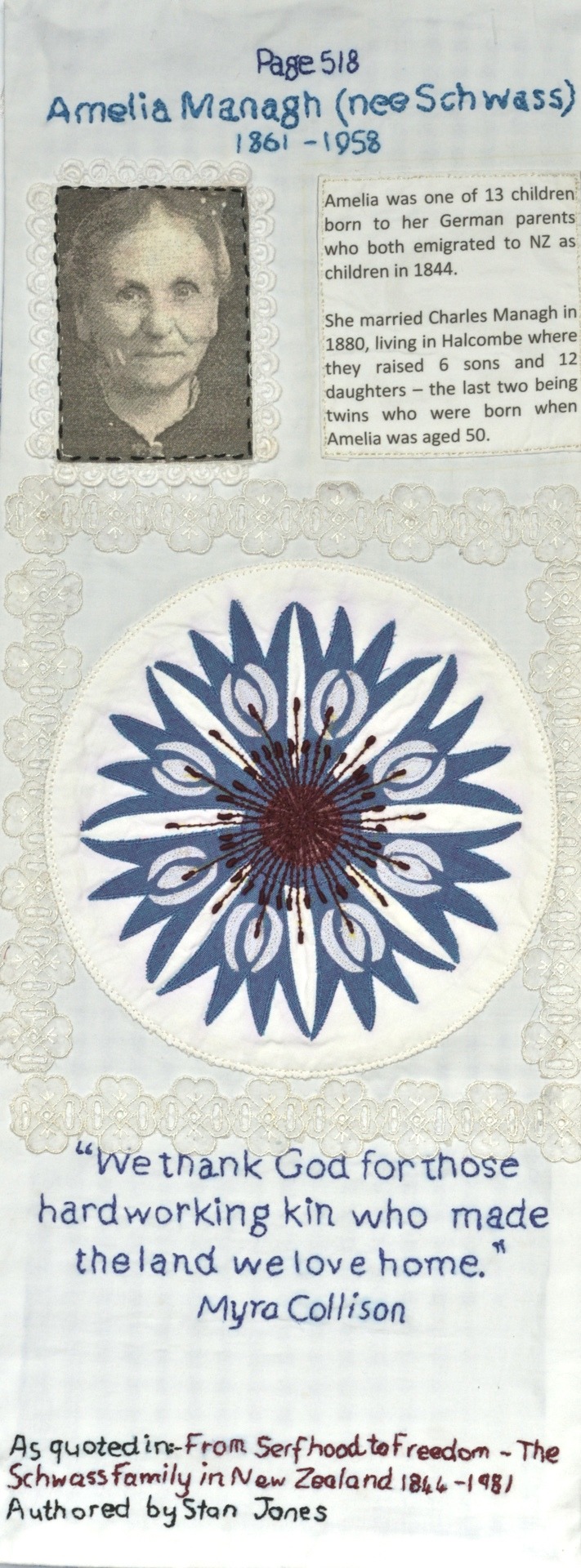Maker: Kate McKenzie
Panel number: 426
Petition sheet number: 518
Person honouring: Mrs Amelia Managh
Relationship to makers: Children’s paternal great-great-grandmother
Amelia Schwass was born to parents who had fled from the horrors of imposed serfdom in the Mechlenburg area of Germany (on the Baltic coast). The land and the families that worked on it were treated cruelly by the nobility. A sympathetic Count paid for the couple’s passage to New Zealand.
Amelia’s father, Ernst, was 12 when he arrived with his father, stepmother, and eight other siblings all under 12. How bad life must have been for them to leave their home land and endure a rugged voyage of 12,000 miles to an unknown country and an unknown future.
Ernst and Annie married in 1857 and had 13 children. Ernst worked in forestry and Annie was a renowned midwife. Amelia was their second daughter, born in 1861 in upper Moutere.
Amelia met her husband, Charles Managh in Halcombe. He too was the child of an immigrant – an Irish family.
Amelia and Charles ran a large farm and raised 18 children – six sons and 12 daughters – the last being twins born when Amelia was almost 50 years old. In spite of the country being ravaged by influenza, diphtheria, and measles at times, they only lost one of those children – little Clement drowned at 18 months after falling into a creek.
A strong intelligent woman, Amelia would have fought strenuously to have her vote count in the country in which she was born and raised. She knew from her family the horrors of what could go wrong when power was imbalanced. She put her name and signature to a document that led the change for parity in New Zealand and round the world.
Amelia and Charles were well respected in the district and community. Charles was guided by Amelia in all his business dealings. Sadly he died aged 65 after a long and painful illness. The twins were only seven years old at that time.
Amelia lived until she was 97 and continued to contribute to her community. She built the Jubilee Hall for the community in 1938 – this later became the Memorial Hall to honour the fallen from both world wars. It is still in use today. She was buried in the Halcombe Cemetery with Charles and baby Clement.
Panel materials: I used an old sheet as the base and strengthened the back with fusible embroidery cloth on areas where it was to be stitched. I used a sticky carrier sheet for the sheeting to go through the printer. Antique lace was used around the photograph and antique fabric for the appliqued flower. The embroidery threads were all from my late grandmother’s needlework bag.
The central flower is the cornflower, the national flower of Germany. The 46 stamen in the centre of the flower represent the other women who signed page 518 of the petition and also the subsequent families that produced (seeded) strong and productive members of our nation. The cornflower is bordered with the Irish shamrock in lace to represent Amelia’s Irish husband.

